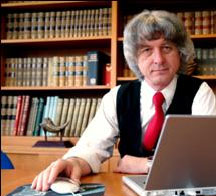
Norman
MacLeod
Keeper of Palaeontology
The Natural History Museum
Cromwell Road, London, SW7 5BD
 Norman MacLeod is the current Keeper of Palaeontology
at The Natural History Museum, London, responsible for all operations of The
Natural History Museum’s Department of Palaeontology. These include the
research, curation, and conservation activities of 46 Grant-in-Aid staff members
along with those of an approximately equal number of students, scientific
associates, honorary research fellows, contract employees, volunteers, etc. Dr.
MacLeod was born in Augsburg, Germany to American parents and grew up in the US
Midwest. He obtained a BSc degree (Geology) at the University of Missouri
(Columbia) in 1975. After teaching secondary school science for two years in
Dallas, Texas he returned to graduate school to take an MSc degree in
invertebrate paleontology and paleoecology at Southern Methodist University
(Dallas) under the direction of Prof. A. Lee McAlister. While at SMU he also
began publishing technical papers in vertebrate paleontology in collaboration
with Prof. Bob. H. Slaughter. Upon completing this degree he moved to a PhD
programme in invertebrate palaeontology at the University of Chicago, but
switched to the University of Texas at Dallas and a micropaleontology research
focus in 1981. During his PhD degree he also held several consulting contracts
at the research laboratories of Atlantic Richfield Oil and Gas Co. in Plano,
Texas and owned a technical photography business. After obtaining his PhD in
1986 (advisor: Prof. E. A. Pessagno Jr.) Prof. MacLeod was awarded a
prestigious Michigan Society Fellowship to study and teach at the University of
Michigan, Ann Arbor. During this period he began publishing on the
morphometrics-biostratigraphy stratigraphy of planktonic foraminifera to his
portfolio and began a research programme into the causes of ancient mass
extinctions. Dr. MacLeod continued this work upon moving from Michigan to
Princeton University in 1989, often collaborating on Cretaceous-Tertiary
planktonic foraminiferal extinction studies with Princeton Prof. Gerta Keller.
In 1996 he accepted a three-year appointment at The Natural History Museum,
London as a visiting scholar. In 1998 he accepted a permanent position at the
NHM from which he moved on to Associate Keeper of the Palaeontology Dept. in
2000 and Keeper in 2001. Prof. MacLeod is the first US national to be appointed
Keeper of any NHM science department in its 250-year history.
Norman MacLeod is the current Keeper of Palaeontology
at The Natural History Museum, London, responsible for all operations of The
Natural History Museum’s Department of Palaeontology. These include the
research, curation, and conservation activities of 46 Grant-in-Aid staff members
along with those of an approximately equal number of students, scientific
associates, honorary research fellows, contract employees, volunteers, etc. Dr.
MacLeod was born in Augsburg, Germany to American parents and grew up in the US
Midwest. He obtained a BSc degree (Geology) at the University of Missouri
(Columbia) in 1975. After teaching secondary school science for two years in
Dallas, Texas he returned to graduate school to take an MSc degree in
invertebrate paleontology and paleoecology at Southern Methodist University
(Dallas) under the direction of Prof. A. Lee McAlister. While at SMU he also
began publishing technical papers in vertebrate paleontology in collaboration
with Prof. Bob. H. Slaughter. Upon completing this degree he moved to a PhD
programme in invertebrate palaeontology at the University of Chicago, but
switched to the University of Texas at Dallas and a micropaleontology research
focus in 1981. During his PhD degree he also held several consulting contracts
at the research laboratories of Atlantic Richfield Oil and Gas Co. in Plano,
Texas and owned a technical photography business. After obtaining his PhD in
1986 (advisor: Prof. E. A. Pessagno Jr.) Prof. MacLeod was awarded a
prestigious Michigan Society Fellowship to study and teach at the University of
Michigan, Ann Arbor. During this period he began publishing on the
morphometrics-biostratigraphy stratigraphy of planktonic foraminifera to his
portfolio and began a research programme into the causes of ancient mass
extinctions. Dr. MacLeod continued this work upon moving from Michigan to
Princeton University in 1989, often collaborating on Cretaceous-Tertiary
planktonic foraminiferal extinction studies with Princeton Prof. Gerta Keller.
In 1996 he accepted a three-year appointment at The Natural History Museum,
London as a visiting scholar. In 1998 he accepted a permanent position at the
NHM from which he moved on to Associate Keeper of the Palaeontology Dept. in
2000 and Keeper in 2001. Prof. MacLeod is the first US national to be appointed
Keeper of any NHM science department in its 250-year history.
Professor MacLeod is an internationally recognized leader in many areas of palaeontology. Prominent among these are (1) quantitative stratigraphical data analysis, (2) morphometrics (the quantitative analysis of form variation), and (3) the causes of Phanerozoic extinction events. Through his work in these areas, he has made significant contributions to the punctuated-equilibrium controversy and the Cretaceous-Tertiary extinction controversy, as well as being personally responsible for the development of several new morphometric data-analysis techniques. He is the co-author of two book-length collections of technical articles: The Cretaceous-Tertiary mass extinction: biotic and environmental changes (W. W. Norton, 1996, with Gerta Keller), and Morphometrics, shape and phylogenetics (Taylor & Francis, 2002, with Peter Forey). In addition to these major publications, Prof. MacLeod is also the creator and Executive Editor of the PaleoBase series of electronic palaeontological databases (Blackwell Science 2001-present), the creator and manager of the PaleoNet palaeontological communications system, and the co-founder and (to 2003) Executive Editor of the first fully electronic palaeontological journal, Palaeontologia Electronica. Professor MacLeod is a frequent contributor to the technical palaeontological literature (over 200 articles published, including many widely-cited review papers), book reviewer, symposium organiser, and keynote speaker at conferences. He has also appeared many times on television and radio programmes discussing paleontological topics. His first love, however, is studying fossils first-hand. He likes nothing better than to pass a quiet afternoon measuring fossils in his high-tech morphometrics laboratory and analyzing those measurements on his collection of computers to tease from them the answers to new riddles from deep time.